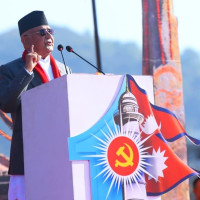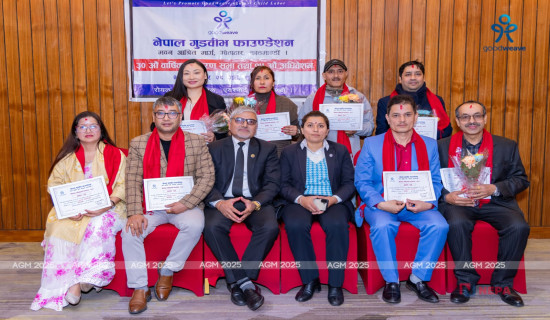- Sunday, 14 December 2025
Nepali movie industry’s digital stride
By Bhesh Raj Karki, Kathmandu, June 27: The Nepali movie industry has taken a digital leap. Having switched to digital from celluloid film back in 2007, the digital journey of the film industry has reached thus far with scores of movies made annually on this technology.
This technology has had its positive impacts in the entire Nepali movie industry. The use of digital technology has boosted the quality and the number of films as well, observed film producer and director Ashok Sharma. Hardly a limited number of movies would be produced a year when celluloid technology was in use. The number has now increased to scores, he said.
Digital technology was a boon for the Nepali film industry when it had taken a back seat being dependent on celluloid when it came to competing with international ‘quality’ movies, he said.
Not long ago, every television show, and commercial, feature films and documentaries were shot on celluloid. Now, with the advent of modern technology, the digital space has fast taken a front seat.
How did we get here?
All Nepali movies would be shot on celluloid. In the old technology, celluloid cameras were used to capture pictures. Motion picture movies are recorded on celluloid film by exposing the gelatin emulsion on the film to light, causing a chemical change in the crystals that can be developed into a visible image.
The images on the film can be projected onto a movie theater screen using a projector to display the moving images. In celluloid film, filmmakers may go through many reels of the film before editing a movie into the final cut.
At that time in Nepali movie industry, only four to five reel prints of the film would be made as the more reel print is made the more it became costlier. It would cost around Rs 1 or Rs 1.2 million to print each reel of the film, said Sharma. Then two reels of the film would be sent outside the Kathmandu Valley, and the remaining two would be kept in the Valley, according to him.
As a result of the limited reels of the film, the movie could not run in all the theaters at the same time. A reel of the film had to be taken from one movie hall to another to show a movie.
There was also a problem of film breaking and scratching as well. Initially, a movie was shot at 35 mm. Later, it was reduced to 16 mm in the hopes of reducing production costs. But it came at a cost of low quality movie, thus losing the audience, said Sharma.
The production cost could not be raised had the movie not been screened in the theatres at the same time, he said, adding that the sound quality was not good either as the sound was recorded and played on tape.
However, film enthusiasts and entrepreneurs had felt that something should be done to improve the condition of the Nepali movie industry. Sharma was closely watching the advent of digital technology in the film industry. “I had felt that the movie quality we were offering to the audience would not last long. Because, we were unable to take a digital stride, as the film industry in other countries had got rapidly transformed going digital,” he said. Nepali movies started losing the audience when the film shoot was reduced to 16 mm from 35 mm, he said.
In this course, Sharma met with a movie hall owner Bhashukar Dhungana who then was at work to carry out a reform in the Jaya Nepal cinema. “I knew that the reform in the cinema aimed to attract the audience by providing quality service.” In the initial days, the theatre would screen only Hindi movies. But it could not attract the audiences. It might be because the audience would want quality service, he said.
“I had always tried my best for the theatre to show Nepali movies. So, the Nepali movie ‘Sukha Dukha’ was screened,” he said, adding however that the movie could not draw large crowds of audience. However, it may be noted that at the same time the Nepali movie had made a record outside the Kathmandu Valley.
“Then I realised that some reforms should be carried out in the Nepali movie industry, something of the introduction of digital technology, the improvement in the ways of film production and storytelling.” Introduced in 2005 in neighbouring India, digital technology was brought in Nepal in 2007 only. “We brought this technology to Nepal with the hope of developing Nepali movies and attracting the Nepali audience to Nepali movies. The Jaya Nepal cinema went digital then,” he said.
Then Sharma, jointly with Dhungana and some others, opened the ‘Digital Cinema Nepal (DCN)’ along with its networking technical partners, UFO Digital Cinema and Scrabble, through which they would spread awareness about digital technology and digitalise theatres. They held many demo sessions about digital technology in movies. Many Hollywood and Bollywood movies were screened digitally at the movie hall.
But there was a setback. The Nepali movies were being shot on celluloid, which means screening celluloid movies digitally was not possible. In the beginning, some producers and directors were not happy with the idea of digitalising Nepali cinemas. They argued that digital technology could not replace celluloid, and it would benefit foreign movies when they were shown digitally.
In a bid to create awareness about digital technology, some people with the DCN produced the reportedly first Nepali digital movie, ‘Kagbeni’. Digital cameras were used and the entire movie making process went digital, said Sharma. Directed by television presenter Bhushan Dahal, Kagbeni took a turn in terms of the style of the movie presentation, storeytelling, character cast, settings and languages used. The audience liked the movie as they could relate the story of the film, the characters and the typical Nepali settings, he said.
“I was convinced that the future of Nepali movies was not possible by ignoring digital technology. I told many that there was no alternative to it. Then, many producers and directors held portions of shares in the DCN. We helped them to make digital Nepali movies,” he said. They have also borrowed money for providing digital service to cinema halls.
The establishment of another company to provide digital service, Cube of Gopi Krishna Movies, helped a lot, contributing to making Nepali cinema halls digital, he said.
The adoption of digital cinema technology has helped theatres to reach out to a large number of the audience and show Nepali movies across the country at the same time with foreign movies, he said.
“The advent of this technology increased the production of Nepali films. So was the quality of the movies, thus attracting the audience to cinema halls,” he said.
But, going to neighbouring India for the encoding started creating a problem and the process was cumbersome. This prompted them to launch the DCN server by bringing hardware from a Singaporean company and software from an Australian company, removing their dependency on India for the encoding only for a short period. Problems surfaced again. “We again talked with the UFO Digital Cinema, and demanded software to operate in Nepal for the encoding. In return, we had to pay royalties, it was agreed,” he said.
Nepali movies like ‘Mahapurush’ ‘Chhakka Panja 4’ and ‘Jari’ have been encoded in Nepal and were run across the globe, he said. This has removed the problem of film piracy, according to him.
There are 175 digital cinema halls (non 2k, 2k and 4k) in operation across the country, he said. (RSS)

.gif)












